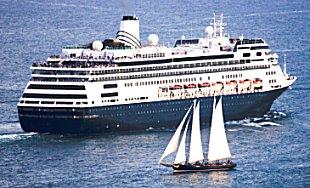
While massive ships with onboard casinos, lounges, pools, spas, and multiple restaurants appeal to many cruise passengers, some travelers prefer the more intimate experience of sailing ships. Before booking passage on a tall-masted schooner, however, passengers should understand the differences between these and other ships so they can choose the best option for their vacation preferences.
Types of Sailing Ships
While there are less than 30 major cruise lines controlling much of the world's cruise vacation market, there are dozens of sailing cruise lines that offer a wide range of experiences for interested passengers. Knowing about the different types of ships allows interested travelers to choose the one that best suits their vacation expectations and needs.
- Experience-Oriented Ships: These sailing vessels offer passengers the opportunity to participate in the day-to-day rigors of sailing, including hauling lines, adjusting rigging, and other necessary tasks. While passengers are not required to put in manual labor to earn their passage, most travelers welcome the novel activities.
- Adventure Cruises: Vessels powered by sails often visit remote, regulated ports that are prohibited to larger ships because of the concerns about what an influx of thousands of travelers would have on the local environment. These cruises are often physically intensive and involve hiking, snorkeling, and other activities to observe local flora and fauna without disturbing them.
- Luxury Vessels: These ships are designed to cater to every need of each passenger onboard with far more exclusivity and intimacy than large liners. While a sailing vessel will not necessarily boast a stunning spa facility or state-of-the-art fitness center, they will have superbly trained staff and all the necessary accouterments to turn any voyage into a wonderful indulgence.
- Chartered Ships: Many sailing ships are charted for private events and group cruises. Weddings and honeymoons are popular options, and chartered sailings can generally be arranged for varying lengths of time and different destinations if desired.
- Theme Cruises: Many sail-oriented companies offer frequent themed voyages to entice passengers to return for new sailings. Common themes include music (jazz or blues, for example), hobbies (history, golf, and cooking are popular), and holiday options.
Itineraries
All sailing vessels are smaller than their contemporary cruise ship cousins, and because of their reduced size, they can frequently visit isolated ports of call that may not have the facilities to accommodate larger ships. This gives them a wide range of itinerary options, including:
- River Cruises: Typically on wide rivers with open geography that will not snare the sails.
- Mediterranean Cruises: Both popular and isolated ports are frequent destinations.
- Bahamas Cruises: A popular option for the Caribbean, including Nassau, Freeport, and various private islands.
- Australia: Australia and New Zealand are popular sailing destinations, as well as other South Pacific nations and isolated tropical islands.
- Asia and Indonesia: Thousands of islands offer a wide range of unique ports for small vessels to visit.
- Greek Island Cruises: Hundreds of islands and a rich history make this an attractive option for sailing vessels.
- The Caribbean: Sailing vessels can visit all the major and minor ports of the southern, eastern, and western Caribbean.
- New England Cruises: A popular option in the fall is New England, particularly Maine, for routes to view spectacular autumn foliage.
- Exotic Destinations: Sailing vessels have even visited remote and unusual destinations such as the Galapagos Islands and Antarctica.
With such a wide range of options, it is no surprise that sailing itineraries also vary in length. Most voyages are at least 5-7 days - these ships, after all, have less powerful engines and take longer to travel between ports than larger vessels. Many sailing itineraries stretch up to 14 or 21 days long, particularly when visiting a number of different ports.
The Sailing Ship Experience
By definition, a sailing vessel is wind-powered with masts and sails providing the primary propulsion. In practice, however, the majority of sailing ships are equipped with modern engines in order to keep itinerary schedules and to compensate when the wind is not cooperative. While most vessels do attempt to use wind power during the voyage, it is not always possible to do so while keeping a tight port schedule.
In addition to the unique allure of stepping back to a time when sailing was a principal means of travel, these ships also offer a more casual, relaxed atmosphere than larger ships. Many sailing vessels do not enforce a rigorous dress code (compared to the formal nights on mainstream vessels), and with the smaller passenger complement, the guests and crew may develop more easy-going relationships, especially on longer sailings.

Because sailing vessels are invariably small, typically accommodating no more than 200 passengers per voyage, they lack extensive entertainment facilities, though a common lounge may provide shows or musical performances. Given the inclusive, intensive nature of most sailing voyages, relevant lectures about the local ecology, environment, history, and culture are common pastimes, as are classes about navigation and sailing in general.
Pros and Cons of a Sailing Cruise
As with any type of cruise line, there are pros and cons to choosing sailing ships.
Pros of sailing cruises include:
- A more intimate experience with local culture and the ship itself.
- Smaller crowds and smaller vessel size.
- More options for isolated ports or adventure sailings.
- A more unique experience than the "cookie-cutter" voyages of major lines.
Cons of sailing cruises include:
- Higher prices due to maintenance costs and the lower number of berths.
- Fewer facilities onboard such as spas, pools, or shopping malls.
- Greater susceptibility to accidents or piracy, in rare instances.
- More emphasis on the ship's motion that may be detrimental for individuals susceptible to seasickness.
- Few, if any, handicapped-accessible facilities.
For more information about sailing ships and their available voyages, consider the two most popular sailing lines, Windjammer and Windstar, or contact a travel agent for options with local or specialty lines.







